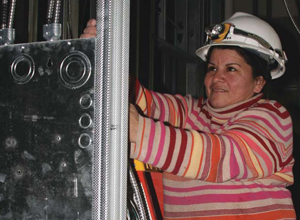
INDERLIED
A lot has been said about Hispanic workers in the construction industry and their higher rate of injuries and fatalities. Getting these workers the information they need to work safely is complicated because six out of 10 speak little or no English. I’ve been on jobsites with many of these workers, and I have a different way of addressing the issue.

My system is based on simple visual cues and non-verbal communication. I also think that keeping some professional distance and decorum on the jobsite—rather than letting everyone joke around freely—is better for everyone.
When hiring a Hispanic worker with little ability to speak or read English, the employer is responsible for getting the safety message through in a way the worker can understand. Managers have to understand a worker’s frame of mind and past experience.
In many Latin-American countries, existing safety regulations may be minimally enforced; in the U.S., regulations are heavily enforced. The Hispanic worker may not necessarily understand the difference in jobsite cultures.
Hispanic workers are production-minded and often do what it takes to fast-track the job. They also may ignore crucial safety practices or simply do the work incorrectly because they mistakenly believe that just getting it done will please the boss.
For example, on one job with which I’m familiar, a Spanish-speaking employee was asked to replace a missing pin on a fire extinguisher. To get it done, the worker found a piece of used wire and then inserted it by tightly twisted it through the hole of the trigger, making the extinguisher inoperable. Not surprisingly, the employee had not been properly trained. If there had been a fire in the area where he was cutting metal studs, the extinguisher would have been useless.
Keeping this in mind, the non-English-speaking worker’s production-only mentality may have to be shifted to a focus on production and sound safety practices.
Don’t Make Assumptions
Education levels can vary from worker to worker, and some Hispanic workers may have had only a grade-school education. Therefore, it shouldn’t be assumed that all of them are proficient in reading or writing their native language, which means the training you provide must be simple, constant and frequently reinforced.
Using solid translators who can be trusted to effectively and accurately get the message across is a big help. Another good practice is to have the employee, prior to doing the task, orally repeat the instructions he or she has just been told.
A very effective way to overcome the language barrier is to have the worker demonstrate the proper procedure—for instance, the correct way of wearing a harness. Using a back-and-forth process, have the worker teach you about safety.
A head nod does not always mean a worker “gets it.” In fact, many times a head nod means “No, I did not understand, but I can’t let you know because you will think that I don’t measure up for the job.” Don’t assume a worker understands just because he or she says yes.
By communicating in Spanish, incorporating visuals (for instance, the safety diagram labeled on a step ladder) and consistently reinforcing the message in a simple manner, many frustrating and costly problems can be avoided.
I would like to make a point concerning a culture of mutual respect at the jobsite. The idea of camaraderie is nice, but it can work against safety. Countless times I have witnessed professionalism and mutual respect become overfamiliarity and disrespect. When group interaction becomes degraded in any way—for example, through horseplay—Hispanic workers will lose respect for authority, cut productivity or leave to work elsewhere. If this becomes part of the job culture, it can have consequences that will ultimately compromise your safety program.
Go the extra mile to encourage these valuable workers to report accidents, injuries and near-misses. Let them know that it helps the entire project and why. Let them know they are responsible for a safe jobsite. After you provide proper training, hold them accountable for their actions. They will value safety as much as you do.


Post a comment to this article
Report Abusive Comment